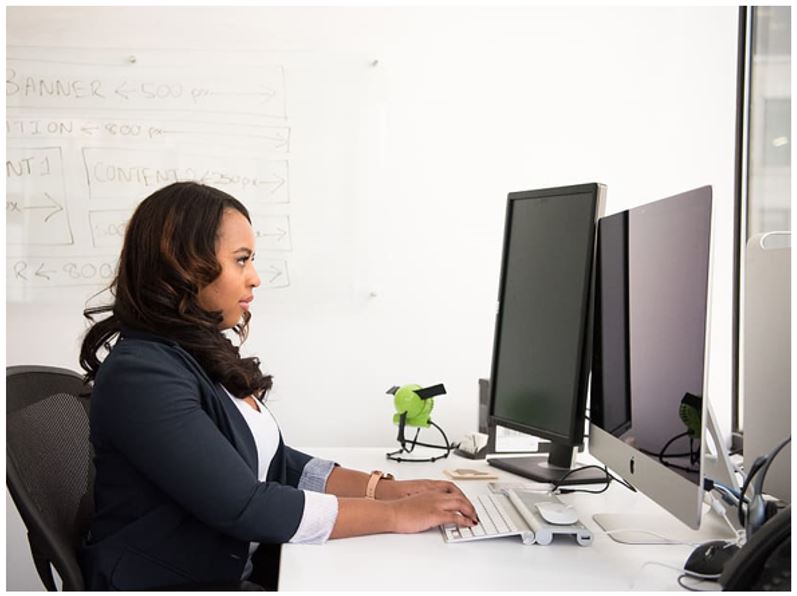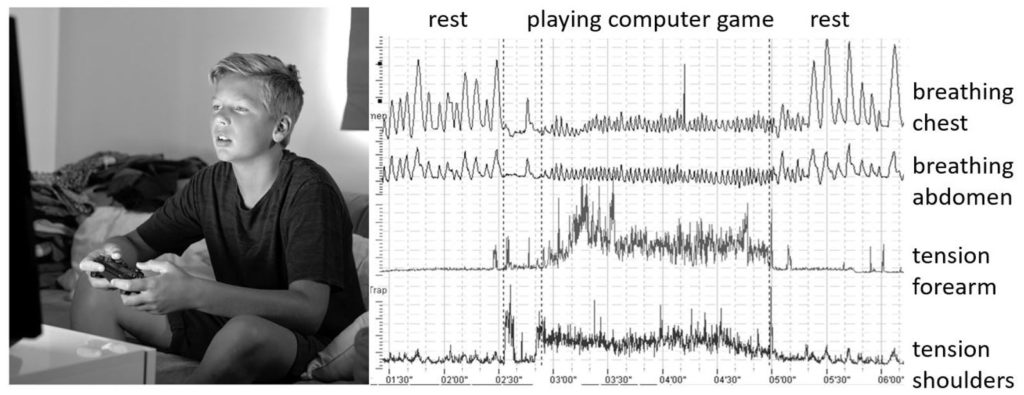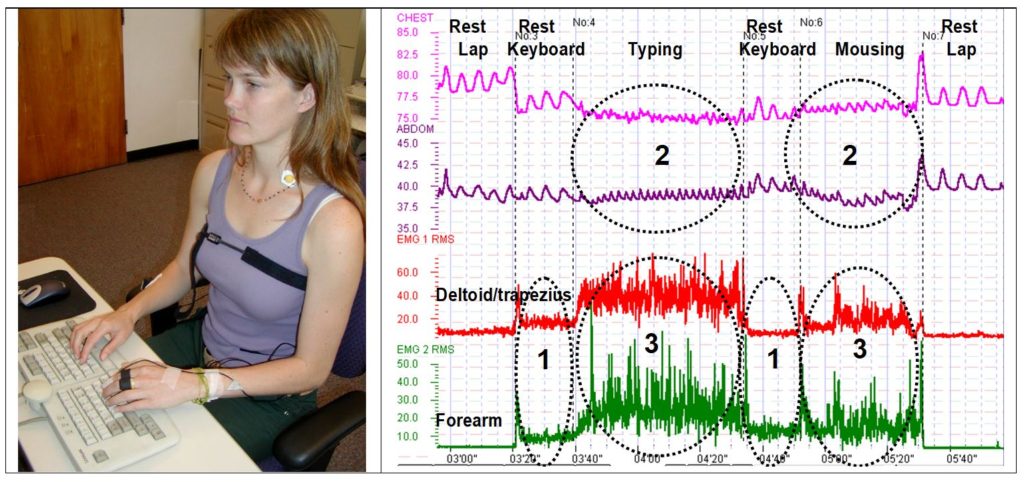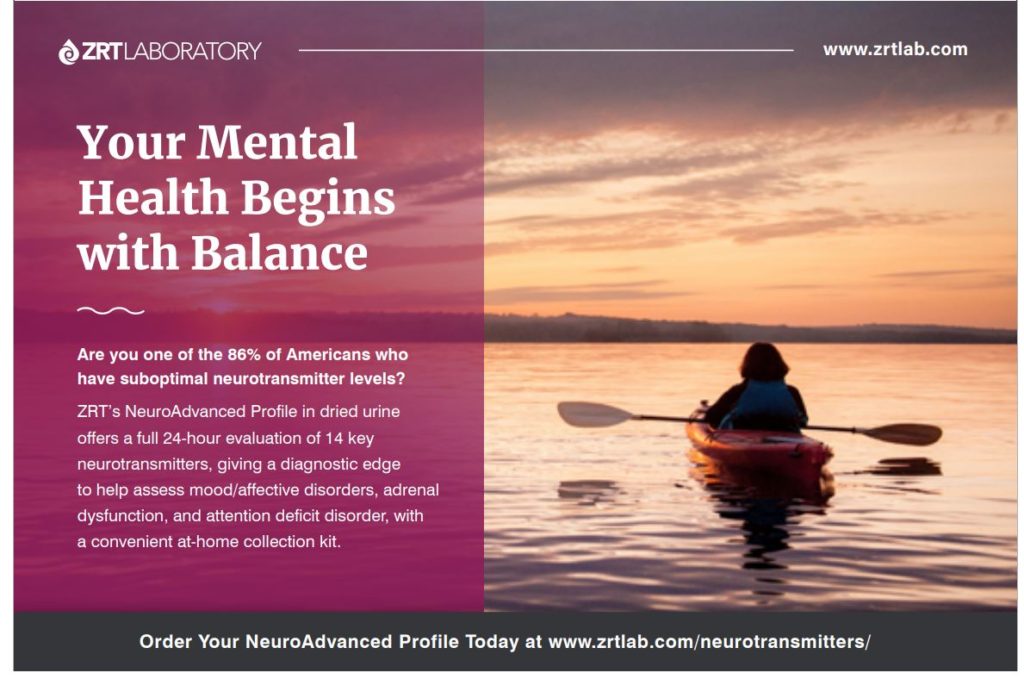By Erik Peper, PhD, BCB and Richard Harvey, PhD
San Francisco State University
CLICK HERE FOR THE FREE CHECKLIST, DESIGNED SPECIALLY FOR READERS OF THIS ARTICLE!
Abstract
The COVID-19 pandemic, almost overnight, has transformed our relationship with technology as we sheltered-in-place. Computer, laptop, tablet, and cellphone screen use has become the main method for maintaining work, education, and social connections virtually. The result has been an increase in symptoms that are physical, behavioral, and emotional in nature. Physical complaints include various neck, shoulder, back, and eye discomfort or pain. Behavioral experiences include insomnia, fatigue, and exhaustion, overindulging on snacks, or skipping meals. Psychological concerns can include making worse symptoms associated with attentional deficits and hyperactivity disorders (ADHD), anxiety, depression, and loneliness. Sometimes, patients or clients use the term Zoom fatigue or COVID stress to refer to a set of symptoms associated with overusing technologies while sheltering in place. Discussed are the following: 1) factors that explain why working with digital devices (computers, laptops and cellphones) can more directly cause and/or indirectly make worse the computer-related disorders; and, 2) evolutionary factors that prime people to respond to phone and computer software notifications and contribute to screen addiction; and, 3) practical suggestions for how to optimize health while using digital devices in a virtual environment.
The COVID-19 pandemic has rapidly transformed our lives in the modern era compared to our ancestors who spent most of their day hunting and gathering resources for survival. Computers, laptops, tablets, and smartphones with large screens have become ubiquitous tools for working, learning, and for connecting, both professionally and socially. Even though some people are already spending a large number of hours with digital devices—and some might say spending too much time using social media apps, or distracting themselves with continuous streams for entertainment—technology is convenient and, for some has become the primary or only way to connect. The result has been an increase in, to coin a phrase, ‘technology-associated overuse’ (TAO) syndrome, marked by physical, behavioral and psychological symptoms such as: neck, shoulder, and back discomfort/pain, eye irritation, insomnia, fatigue and exhaustion, overindulging on snacks or skipping meals, attentional-deficits and hyperactivity disorders (ADHD), anxiety, depression, and loneliness.1-8
People use digital devices all day, every day with little awareness of the toll associated with continuous screen interactions. Some people amplify their habits of continuously and/or unconsciously checking for text messages multiple times an hour, descending into a rabbit hole of ‘click-bait,’ following link-after-link, or playing countless rounds of computer games for hours without a break.9 On the average we now check our phones 96 times a day—about once every 10 minutes and an increase of 20% as compared to two years ago.10 For many students, the last thing before sleep and the first thing before getting up is checking the phone. Even during social interactions with other people, we may automatically check our phones for social media and text notification. Thus, we engage in a form of ‘semi-tasking’ (e.g. doing twice as much, half as well), not fully paying attention to the people we are with or to the people at the other end of a text message.
Even though digital communication has numerous benefits (e.g., connecting with friends and family on social media, reduction or elimination of commuting), 94% of our college students report that online synchronous learning while sheltering in place (e.g. via Zoom) is more stressful and challenging than in person learning.11 Similarly, many faculty report that teaching remotely (e.g. via Zoom) is more exhausting. Some of the factors that contribute to this exhaustion includes the following:
- Lack of movement as the person sits with minimal movement.12
- Near-field vision stress as the person looks at the screen. The eyes converge and accommodate, without allowing the eye muscles to relax by looking at the distance.
- Difficulty in sensing nonverbal communication cues (body movement, breathing patterns, eye movement, body odors, etc.).13,14
- Reduced facial feedback (non-responsive face, reduced screen resolution, the face appears dark because of back lighting, or in gallery view the face picture is very small). For the viewer (e.g. a teacher) non-responsive faces covertly evokes the feeling of danger.15
- Incorrect ergonomics (arrangement of chair, keyboard, monitor, lighting, etc.).16
- Lack of somatic awareness of static muscle tension and shallow breathing (shoulder muscle tension while mousing, head forward or downward to read the screen or look at the cellphone).17
The COVID-19 pandemic supercharged a social trend of the last 20 years towards encouraging working and learning from home. One benefit is the reduced expenses associated with commuting, office rent, or room and board in dorms, as well as to provide increased access to the information (e.g. more people can work and learn from home).18 Similarly, telemedicine and teletherapy are transforming health care delivery, including facilitating on-screen diagnoses using high-definition cameras, and real-time (synchronous) interactions with therapists.19,20 Unfortunately, the overuse and over dependency on screens (e.g. digital devices with screens) for work, education, entertainment, and socializing contributes to an increase in tech stress symptoms.
This article explores why people may develop discomfort while using digital devices as compared to a time in history when technology included working on a typewriter. Strategies to reduce discomfort and enhance health with digital devices are presented next.
Why do some people develop symptoms of stress and strain, dubbed ‘technology-associated overuse’ while working at the computer compared to working at a device such as a typewriter?
Although data entry with a typewriter (typing) and data entry at the computer appear similar, there are differences worth noting.

Working at a typewriter
Movement differences.
Typing incorporates episodic motor movements (e.g., carriage return, inserting single sheets of paper and filing the typed papers) that interrupts the static arm, back, legs, neck, and shoulder tension. On the other hand, computer data entry is predominantly a static sitting task as illustrated in Figure 1a and 1b.
Computer keyboarding and mousing typically involves only finger and arm movement for data entry. The data entry tasks can continue for extended time periods while the person sits without large motor movements. The computing task does not intrinsically incorporate body movements to interrupt static muscle tension as the use focuses on the screen, captured by the content or task.

Working at a computer
It is no wonder that for some people hours pass before taking even the briefest movement break (a micro break for a few seconds), or a longer mini or macro break such as stretching in place or getting up out of our seats for a short walk. Modern interactions with digital devices lead to increasing muscle tension without awareness and a significant decrease in blood flow. Unfortunately, blood and lymph fluids may pool in the lower portion of the body from lack of leg movement, which is so important that the muscles of the calf have been called the second heart because they help return the blood against gravity back to the core.
Even when ‘interrupt’ programs are used to remind us to move our bodies, we often ignore them or turn them off because it is inconvenient or, just easier to continue to work. No wonder that more and more people experience discomfort all day long while using digital devices. Technology-associated overuse results in an increase in “sitting diseases” such as hypertension and musculoskeletal pain disorders, where people who sit six hours a day have a 19 percent increase in death rate from all causes as compared to those who sit less than three hours a day. 21,22 To repeat a generic phrase, sitting is the new smoking.
Vision differences. Typists usually could look alternately at near and far distances when engaging with the material on the page. For example, a typist would focus on things farther away each time they changed the paper in the typewriter. Every time the eyes could focus on a far distance, the eye muscles could relax, and therefore reduce near-field visual stress.
Today, most computer screens are typically positioned about 18 inches from our eyes. People typically only look at near-field objects displayed on the screen, or look at a wall, or at a partition right behind the screen. When looking at a cellphone screen, we look ever closer, about 10 to 15 inches away. The muscles that cause the eyes to converge and the lenses to focus have no opportunity to relax, which can only occur by looking away at the far distance. At the same time, our blinking rate is reduced when we attend to new stimuli.23 Consequently, many people suffer from eyestrain and dry eyes in addition to muscle strain from immobility of sitting for hours working at a computer.24,25
Taking timeout to regenerate differences. Today, modern work can be performed anywhere and anytime 24 hours a day, 7 days a week, and 365 days a year.At home we often continue to do more office work, email a friend, text, read digital books, search the internet, and participate in social media, all in a fluid continuum of never-ending digital screen interactions – and some might say digital distractions. Even when on holiday, we may keep in contact with the office. The consequence of the conveniences of being able to access many activities instantly may mean there is less time to regenerate physically and mentally and spiritually, seldom stopping to ask, “why am I feeling so tired.”
Sitting difference (e.g. slouched and collapsed). When sitting and looking at the screen or cellphone many people tend to slouch and bring their head forward to read the screen. The slouched posture with a head forward position tends to increase neck muscle tension leading to muscle tension headaches, with accompanying decreases in subjective energy and reduction of positive thoughts.26-29
Impact on Children’s Health
In the past, children’s daily life included more outside play which supported many kinds of muscle development.30-32 Without awareness, children developed motor coordination, alternated between looking at near and far objects that reduces near visual stress, and played ‘freeze, stop and start’ movement games that developed self-control. Children did not learn to use a typewriter until they were in their middle or high school years.
Today, babies and children are often given a cellphone or tablet early in life, which serves as a digital ‘baby-sitter’ since visual displays capture their attention. Unfortunately, overuse of technology can result in spending hours looking at screens without interruption. The result? Predominantly near-vision focus that affects eye development and increases near-vision stress (e.g. increased convergence and accommodative dysfunction) to the point that there is an increased prevalence in developing early onset myopia.33-35 For example, over 85% of Singapore’s young people today wear glasses, related in part to technology-associated overuse.36,37 Arguably, schoolchildren in many parts of the world, including East Asia, spend their childhood predominantly looking at screens instead of playing outside and relaxing their eyes by looking at far distances, possibly contributing to myopia.
As children become ‘captured’ by the screen, they tend to stay in the same static position often resulting in little or no change in body movement with an increase in static muscle tension.38 At the same time, the multimedia content in the screen captures their attention and increases their arousal as indicated by their shallow, rapid breathing (see Figure 2).

content. During the entire duration of gaming some children will breathe rapidly
with static tension in their forearm and neck and shoulder muscles.
(by permission from Peper, Burke & Peper, 2002; Peper, Harvey, & Faass, 2020)
Increased screen time has been identified as a cofactor in developing sleep disturbances, attention deficit disorders, hyperactivity disorders, overweight and obesity disorders, and Asperger’s syndrome.39-41
Why are we so easily captured by the screen’s content and by digital notifications (e.g texts or instant messages)? Computer displays, cellphone apps, and social media capture our attention without awareness because the visual and auditory signals activate physiological responses that in ancient times supported our survival. Continuous overuse of the automatic response patterns that supported our survival may unintentionally contribute to various kinds of physical symptoms because of the overuse. The hijacking of the body’s responses that evolved to get us out of danger by the audio, video and vibratory signals from modern digital devices have been described by Peper, Harvey and Faass (2020) in their book, TechStress: How Technology is Hijacking Our Lives, Strategies for Coping, and Pragmatic Ergonomics, and include the following:
We are wired to identify danger, which means we tend to react to any stimuli that suggests potential danger as well as the presence of food sources (e.g. game animals). Whether the stimuli is auditory, visual, tactile, or kinesthetic, those stimuli trigger arousal. This arousal occurs to both real as well as virtual stimuli because our biology compels us to respond to virtual stimuli presented on digital devices. Because digital content can be omnipresent, always beckoning, ‘come hither and stick around’ it evokes ‘screen addiction’. From an evolutionary perspective, even though we were once triggered to move our bodies in response to ‘real world’ survival signals, today we may not have an opportunity to move our large muscles as much or as often, and instead get to hold ourselves fixed in place, moving only our hands or fingers. Unfortunately, we never get to complete the range of actions and movements that co-evolved to support our survival during a time when we had to hunt and gather food, or fight or flee to survive predators or enemies. In ancient times, the signals that identified danger or were tied to our survival led to relatively short-lived experiences. Today, we may be exposed to a continual stream of stimuli that evoke arousal associated with survival; however, instead of hunting and gathering, or fighting or fleeing, we stay seated, relatively immobilized, and do not act or move our large muscles for defense or survival. Unfortunately, the ongoing arousal and vigilance triggered by modern digital device content is coincident with static muscle tension, such as tightening our neck and shoulders muscle, (e.g. increased low level trapezius muscle tension) and changes in heart rate and breathing patterns (e.g. decreased HRV and increase shallow breathing).
We are wired to conserve energy in order to heal and regenerate. Not moving our bodies, because we are sitting all day looking at screens. reduces energy expenditure. The biological consequence can include increases in fat storage, arguably a physiological mechanism that evolved that allows people to survive longer when food is scarce. Unfortunately, the ability to preserve energy stores (e.g. increase fat stores) combined with lack of movement and sedentary lifestyle (e.g. ‘sitting disease’) contributes to development of obesity, diabetes, and cardiovascular disease.
We are wired to see digital images and sounds as if they are real. The brain does not discriminate between actual and visual-auditory images that are artificial, digital recreations, which explains one aspect of our attraction to our phones, to binge watching, and to gaming. Our bodies, nervous system, and emotions respond to virtual content in the same way as real, lived experiences, which contributes to ongoing, continual arousal and physiological stress for as long as we use digital devices, and arguably longer than the time it takes to hunt and gather, or fight or flee.
We are wired to be active during daylight. Blue-white light sources from our phones and computers stimulate the central nervous system as if it were daylight. Watching a screen before going to sleep inhibits melatonin production and increases arousal as we react to the updates on social media or watch arousing media. Even when there are apps that change our screens’ frequency of light (e.g. to a ‘night-mode’), the content of the visual images and sounds may represent daylight activity, so the body responds by keeping us awake contributing to disordered sleep.42,43

the evolutionary survival response.
(image: staticflickr.com)
We are wired to attend to social information about power structure and hierarchy. The particular cues in social media related to power structures and hierarchy contribute to social media addiction because we continuously feel the need to know who has power and be updated about what is going on regarding who may have power over us. Unfortunately, even with friends or family with whom we feel safe and secure in our relationships, we feel the urge to check the notification or social updates to make sure that our social status in some hierarchy has not shifted.
Although many response patterns that evolved for our survival are evoked by the content of work or media presented on digital devices, we tend to blame the individual for lacking control (e.g., they are addicted, lazy or lack self-control) over their responses. The blame may be more justly placed on the technology companies who have designed the hardware platforms and software content to capture our attention by exploiting the human evolutionary response patterns. We need to move away from blaming the individual for responding automatically to the stimuli to recognizing that the companies have developed the displays and notification to trigger these evolutionary survival responses—these automatic responses have become evolutionary traps. It is similar to blaming a child for wanting candy at the supermarket checkout counter. Instead, we should blame the store and the food industry for evoking the child’s response. Solutions need to include reducing the exposure to the stimuli, especially for young children.
Teaching Awareness with Biofeedback to the Rescue

Note the following: 1) forearm and shoulder (deltoid/trapezius) muscle
tension increased as the person rests her hands on the keyboard without
typing; 2) respiration rate increased during typing and mousing; 3) shoulder
muscle tension increased during typing and mousing; and, 4) there were
no rest periods in the shoulder muscles as long as the fingers are either
resting, typing, or mousing (reproduced from Peper & Harvey, 2008).44
When working at the computer, most people are unaware of the low levels of chronic muscle tension in their shoulders and their forearm during data entry. They also breathe shallowly and rapidly. Even when they think they are relaxed, their muscles are still slightly contracted as shown in Figure 4.
In almost all cases, the person is unaware of the physiological changes such as increased muscle tightening and reduced breathing that occur. The biofeedback monitoring of respiration and muscle tension make the invisible visible and the covert overt. The visual and auditory feedback provides evidence and a rational of why physical symptoms may develop such as chronic low-level muscle tension and increased sympathetic arousal. More importantly, feedback training can support strategies for learning how to work with less static muscle tension/overexertion and healthier breathing (e.g. lower and slower breathing). With regular feedback, people can learn awareness of muscle tension and work without tightening unnecessary muscles. For detailed instructions how to use devices that provide muscle feedback (e.g. EMG protocols) for assessment and training see Peper, E. & Gibney, K. H. (2006). Muscle Biofeedback at the Computer: A Manual to Prevent Repetitive Strain Injury (RSI) by Taking the Guesswork out of Assessment, Monitoring and Training. Biofeedback Foundation of Europe. (Free download available from: http://bfe.org/helping-clients-who-are-working-from-home/)
How to Thrive and Survive in a Digital Environment
Maintaining health and preventing discomfort at the computer is more than learning muscle awareness and physiological control. Healthy computing and digital device use need to include a ‘systems perspective’ that accounts for the triggering of evolutionary traps, lack of body awareness while focusing on the work task, and training in awareness with biofeedback to enhance health.
Implement the following camera and sound recording guidelines to improve communication and teletherapy for your clients and patients.
- Arrange the camera so that your face is clearly visible (eliminate back lighting and provide light onto the face. Be aware when the camera records from the side because the viewer may believe you are looking away from them and are not attending to them directly.
- When possible, use a separate microphone for better sound quality.
- If the screen freezes or the sounds warbles (possibly due to WiFi bandwidth issues) turn off the screen so that the sound is better and upgrade internet connection.
- Ask people to sit further back so that you can see non-verbal communication cues such as arm, trunk, leg and breathing movements.
- Review ergonomic guidelines to optimize health at the keyboard.
Finally, implement the following pragmatic suggestions to enhance health at the computer and optimize bio and neuro-teletherapy and telebio-/neurofeedback.
- Use biofeedback to demonstrate or model or ‘show and tell’ for your clients and patients how your body responds during interactions with digital devices, before guiding them in learning a technique.
- Incorporate many movement breaks is a series of microbreaks (e.g. 30 seconds or less), minibreaks (a few minutes or less) and longer breaks (e.g. more than a few minutes). Every few minutes move and wiggle so that the muscles can relax (think of the typist inserting a new sheet of paper in the typewriter).
- Practice deliberate large movement breaks to interrupt sitting disease (think of the typist getting up and filing the paper, or walking to the next room to the printer).
- Learn slow diaphragmatic breathing that lasts at least 10 seconds, breathing in and out. When you become aware of shallow rapid breathing or breath holding, pause to practice slower breathing through the nose.
- Optimize the ergonomics for your particular needs by avoiding ‘one-size-fits-all’ equipment. Remember that if the chair does not fit your body, it is incorrect, and you can only sit uncomfortably. Even when a chair is ergonomically correct, it does not mean that you will sit in it correctly, so take the time to adjust the chair to your needs. Unfortunately, you may still tend to slouch and work under stress, thus, pay attention to your work style.
- Schedule uninterrupted work time so that your productivity is not disrupted by notifications, emails, or phone calls except for a “true” emergency.
- Turn off digital ‘distraction’ devices when socializing such as during dinner, talking with friends, or playing with children.
- Limit any digital device exposure for children. Let them entertain themselves by playing actual physical movement games. Outdoor games facilitate motor development and also teach children impulse control mastery. Games, such as red-light green-light or hide-and-seek, encourage children to stop and freeze or stay totally quiet so not to give away their location.
- Avoid arousing content and bright digital screens an hour before going to bed to reduce blue exposure and sympathetic arousal.
- Practice daily relaxation/meditation exercises to quiet the emotions and mind.
For the comprehensive background and guidelines see the book, TechStress- How Technology is Hijacking our Lives, Strategies for Coping and Pragmatic Ergonomics, by Peper, Harvey and Faass (2020).
References
- Stanam A, et al. Exposure to Computer Work and Prevalence of Musculoskeletal Symptoms Among University Employees: A Cross-Sectional Study. Journal of Environmental Health.2019; 81(7): 14-19.
- Twenge JM, et al. Age, period, and cohort trends in mood disorder indicators and suicide-related outcomes in a nationally representative dataset, 2005–2017. Journal of Abnormal Psychology. 2019; 128(3): 185–199.
- Borhany T, et al. Musculoskeletal problems in frequent computer and internet users. Journal of Family Medicine and Primary Care. 2018; 7(2): 337–339.
- Alhadi A, et al. The Association between time spent on computer tablets and attention deficit hyperactivity disorder (ADHD) among children from 3 to 12 years old. European Psychiatry. 2017;41(S1): S146-S146.
- Jensen, C, et al. Musculoskeletal symptoms and duration of computer and mouse use, International Journal of Industrial Ergonomics. 2002; 30(4-5): 265-275.
- Campbell AM. An increasing risk of family violence during the Covid-19 pandemic: Strengthening community collaborations to save lives. Forensic Science International: Reports. 2020; 2: 100089.
- Seki T, et al. Relationship between internet addiction and depression among Japanese university students. J Affect Disord. 2019; 256: 668-672.
- Son C, et al. Effects of COVID-19 on College Students’ Mental Health in the United States: Interview Survey Study. J Med Internet Res. 2020; 22(9):e21279
- Kardaras, N. (2017). Glow Kids, New York: St. Martin’s Griffin.
- Asurion Research (November 19, 2019).Americans Check Their Phones 96 Times a Day. https://www.asurion.com/about/press-releases/americans-check-their-phones-96-times-a-day/#:~:text=Despite%20our%20attempts%20to%20curb,tech%20care%20company%20Asurion1.
- Peper E, Wilson V, et al. Avoid Zoom fatigue, be present and learn. NeuroRegulation. 2021; 7(1).
- Streb J, et al. Extremely Reduced Motion in Front of Screens: Investigating Real-World Physical Activity of Adolescents by Accelerometry and Electronic Diary. PLoS ONE, 2015;10(5): e0126722.
- Lapakko D. Communication is 93% Nonverbal: An Urban Legend Proliferates. Communication and Theater Association of Minnesota Journal. 2007; 34: 7-19.
- Kendon A. (2004). Gesture: Visible Action as Utterance. Cambridge, England: Cambridge University Press ISBN-13 : 978-0521835251
- Porges, S.W. (2017). The pocket guide to the polyvagal theory: The transformative power of feeling safe. New York: W. W. Norton & Co. ISBN-13: 978-0393707878
- Peper E, Harvey R, Faass N. (2020). TechStress: How Technology is Hijacking Our Lives, Strategies for Coping, and Pragmatic Ergonomics. Berkeley: North Atlantic Books.
- Peper E, Harvey R, Tylova H. (2006). Stress protocol for assessing computer related disorders. Biofeedback. 34(2), 57-62. https://www.aapb.org/files/publications/biofeedback/2006/biof_34_2_stress.pdf
- Brynjolfsson E, et al. COVID-19 and Remote Work: An Early Look at US Data. The National Bureau of Economic Research, Working Paper No. 27344. Downloaded July 3, 2020. https://www.nber.org/papers/w27344
- Mann DM, et al. COVID-19 transforms health care through telemedicine: Evidence from the field, Journal of the American Medical Informatics Association. 2020; 27(7), 1132–1135,
- Peden C, Hochman M, Turner BJ. (March 24, 2020). Coronavirus is driving a big shift in health care toward telemedicine. USC Anneberg Center for Health Journalism. Downloaded July 3, 2020. https://www.centerforhealthjournalism.org/2020/03/23/coronavirus-driving-big-and-lasting-shift-health-care-toward-telemedicine
- Stamatakis E, et al. Sitting time, physical activity, and risk of mortality in adults. J Am Coll Cardio. 2019; 73(16): 2062-2072.
- Patel AV, et al. Prolonged leisure time spent sitting in relation to cause-specific mortality in a large US cohort. American Journal of Epidemiology. 2018; 187(10): 2151–2158,
- Wascher E, et al. Eye-blinks in choice response tasks uncover hidden aspects of information processing. EXCLI journal. 2015; 14: 1207-1218. https://doi.org/10.17179/excli2015-696
- Nunes AF, et al. Convergence insufficiency and accommodative insufficiency in children. BMC Ophthalmology. 2019;19(1): 58. https://doi.org/10.1186/s12886-019-1061-x
- Sheppard AL, Wolffsohn JS. Digital eye strain: prevalence, measurement and amelioration, BMJ Open Ophthalmology. 2018; 3:e000146. https://bmjophth.bmj.com/content/3/1/e000146
- Harvey R, et al. The effect of head and neck position on head rotation, cervical muscle tension and symptoms. Biofeedback. 2018;46(3), 65–71. https://doi.org/10.5298/1081-5937-46.3.04
- Peper E, Lin IM. Increase or decrease depression: How body postures influence your energy level. Biofeedback. 2012; 40(3), 125-130. https://doi.org/10.5298/1081-5937-40.3.01
- Tsai HY, Peper E, Lin IM. EEG patterns under positive/negative body postures and emotion recall tasks. NeuroRegulation. 2016; 3(1), 23–27. https://doi.org/10.15540/nr.3.1.23
- Peper E, et al. (2017). How posture affects memory recall and mood. Biofeedback. 2017;45 (2):36-41.
- Hinkley T, et al. Cross sectional associations of screen time and outdoor play with social skills in preschool children. PLoS ONE. 2018;13(4): e0193700. https://doi.org/10.1371/journal.pone.0193700
- Webster EK, Martin KC, Staiano AE. Fundamental motor skills, screen-time, and physical activity in preschoolers. Journal of Sport and Health Science. 2019; 8: 114-121. https://reader.elsevier.com/reader/sd/pii/S2095254618301054?token=56D94270F75DBD331B6DC32960603F96D3363C112090527D7886BCF7439CF8338834BB07EA3969E210C81FF37D00D6AA
- Cadoret G, et al. Relationship between screen-time and motor proficiency in children: a longitudinal study. Early Child Development and Care.2018; 188(2): 231-239. https://doi.org/10.1080/03004430.2016.1211123
- Enthoven CA, et al. The impact of computer use on myopia development in childhood: The Generation R study. Preventative Medicine. 2020; 132: 105988. https://doi.org/10.1016/j.ypmed.2020.105988
- Sherwin JC, et al. The association between time spent outdoors and myopia in children and adolescents. Opthalmology. 2012;119(10): 2141-2151. https://doi.org/10.1016/j.ophtha.2012.04.020
- Schneider M. (2016). Vision for Life, Revised Edition: Ten Steps to Natural Eyesight Improvement. Berkeley: North Atlantic Books. https://self-healing.org/shop/books/vision-for-life-2nd-ed
- Sensaki S, et al. An Ecologic Study of Trends in the Prevalence of Myopia in Chinese Adults in Singapore Born from the 1920s to 1980s. Ann Acad Med Singap. 2017; 46(6): 229-236. PMID: 28733687. https://pubmed.ncbi.nlm.nih.gov/28733687/
- Grzybowski A, et al. A review on the epidemiology of myopia in school children worldwide. BMC Ophthalmol, 2020;20:27. https://doi.org/10.1186/s12886-019-1220-0
- Peper E, Burke A, Peper EJ. Captured by the Computer: A Psychophysiological Profile of Boys Playing Computer Games. Applied Psychophysiology and Biofeedback. 2001; 26(3): 241.
- Swingle M. (2019). i-Minds – 2nd edition: How and Why Constant Connectivity is Rewiring Our Brains and What to Do About it. Gabriola, BC, Canada: New Society Publishers
- Tamana SK, et al. Screen-time is associated with inattention problems in preschoolers: Results from the CHILD birth cohort study. PLoS ONE. 2019;14(4): e0213995. https://doi.org/10.1371/journal.pone.0213995
- Tandon PS, et al. Physical activity, screen time, and sleep in children with ADHD. Journal of Physical Activity and Health. 2019;16(5): 416-422 https://doi.org/101123/jpah.2018-0215
- Hysing M, et al. Sleep and use of electronic devices in adolescence: results from a large population-based study. BMJ Open. 2014; 5(1): e006748. https://doi.org/110.1136/bmjopen-2014-006748
- Bowler J, Bourke P. Facebook use and sleep quality: Light interacts with socially induced alertness. Br J Psychol. 2019;110: 519-529. https://doi.org/10.1111/bjop.12351
- Peper E, Harvey R. From technostress to technohealth. Japanese Journal of Biofeedback Research. 2008; 35(2): 107-114. https://www.jstage.jst.go.jp/article/jjbf/35/2/35_KJ00005060045/_pdf
Correspondence should be addressed to:
Erik Peper, Ph.D., Institute for Holistic Healing Studies/Department of Recreation, Parks, Tourism and Holistic Health, San Francisco State University, 1600 Holloway Avenue, San Francisco, CA 94132 Email: epeper@sfsu.edu web: www.biofeedbackhealth.org blog: www.peperperspective.com













